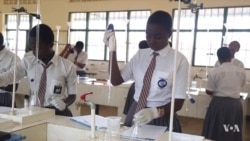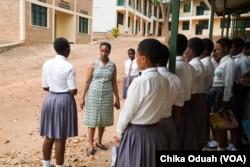Eighteen-year-old secondary school student Yvonne Kevia pours a clear liquid into a burette, watching the bubbles flow down the long, glass tube. After mixing and measuring, the liquid turns bright pink.
Kevia writes down measurements in her notebook.
The aspiring chemical engineer has just performed a titration, but we are witnessing more here than just a simple laboratory procedure. Rwanda is making a push to equip girls for science-related careers and is creating a model for other African governments to follow.
Kevia's classmate Keza Marie Aimeé is planning on becoming a pilot. Her backup plan is to be a pharmacist.
“The first thing that came to my mind before choosing this school was that I wanted to live with girls who know what they want. The reason why I want to become a pilot is because we’re having just few girls that are pilots and I want to show people that yes, we can as girls,” Aimeé says.
The FAWE Girls’ School, where Aimeé has been a student for the past three years, is part of a proliferation of STEM-focused schools in Rwanda over the past decade. FAWE is considered one of the best. The boarding school admits girls from impoverished backgrounds. On national exams, FAWE students overwhelming score in the top percentile.
“It’s a belief of many that girls cannot perform as good as boys, but that is not correct. So believing that they have that potential of doing sciences as well as boys, I think it’s very good for them because with sciences, one can do many things,” says Pascale Dukuzi, a chemistry instructor at FAWE Girls’ school.
WATCH: Girls in STEM
Rwanda’s Ministry of Education reports that the number of females studying STEM in school continues to rise. The latest statistics from the Ministry of Education say in 2015, 55.1 percent of girls in secondary schools opted to enroll in science classes, up from 48.7 percent in 2011.
It is no accident. The government has been on a mission to transform the economy by 2020, in part by promoting careers in science, technology, engineering and mathematics, or STEM fields.
“Africa faces a dire deficit in skilled workers in the applied sciences, engineering and technology (ASET) fields. There is one or less scientist or engineer per 10,000 people, compared with 20 to 50 in industrialized countries,” according to a 2015 World Bank report.
Rwanda leads the way
The World Bank cites Rwanda as one of a handful of African countries leading the way in working to boost STEM education at tertiary and vocational schools.
The country came in third in a 2017 report that ranked the capacity of African governments’ agendas to developing science and technology, commenting on the government’s effective policies to encourage the expansion and development of STEM with initiatives that include establishing a science ministry, research institutions, partnering with private groups and awarding scholarships.
The Ministry of Education has seen its budget climb nearly 10 percent from last year to 240.9 billion Rwandan francs [$280 million] in 2017, of which 14 percent is allocated for STEM projects, including developing “smart classrooms” equipped with computers and internet connectivity and building a building a center for theoretical physics. The government wants to double the current budget allocation for STEM education at the university level. Currently, 80 percent of students in Rwanda receiving government scholarships pursue STEM programs.
When it comes to getting more girls and women into STEM, advocates say the younger, the better. Exposure to science in primary school matters.
Jeannette Gahunga, who graduated from university three years ago with a degree in computer programming, is now a volunteer teacher at a public primary school in Kigali.
She stands in the front of the classroom, displaying a screen to the students. They watch her and turn to their laptops to create interactive animations using scratch programming.
Half the students in this classroom are girls, and Gahunga says she keeps a close eye on them. Mentorship is key to keeping girls on the STEM track.
“They're able to make innovation, and they are not as shy as before. Now they are really learning very hard. The girls in my class are doing the same as boys. They are as hardworking as others and they are following very well,” Gahunga says.
Cultural and historic barriers are still a challenge. Girls and young women in Rwanda face cultural expectations to prioritize getting married and raising a family.
“Culturally, African girls and women were the people to stay in the backdoors and never on the front line. So, even when education came and people embraced education, they were educating men, and women were only educated to take care of the children and that was the end of the story,” says Josephine Kobusingye, an education activist.
“A serious challenge is the aftereffects of the genocide. Some of these girls are orphans. Some of them come are living with step parents who do not support their education because again, many fathers were killed during the genocide and women remarried. Some of the girls have HIV-infected parents. These girls are dealing with so much, poverty. They have my contact and they call me sometimes saying they don’t know how to keep going. Life becomes too much. But there is an array of hope with STEM and I don’t want anything to shake that hope in them.
Kobusingye takes part in support group meetings in Kigali, where female science students from various schools meet to interact and talk about their professional goals.
Support comes in other ways as well.
On a rare visit to see her family, Yvonne Keza embraces her mother with a smile. Her mother is a domestic house helper. Her father is still recovering from being violently attacked during the 1994 genocide.
Keza is the only one in school and the family is counting on her.













